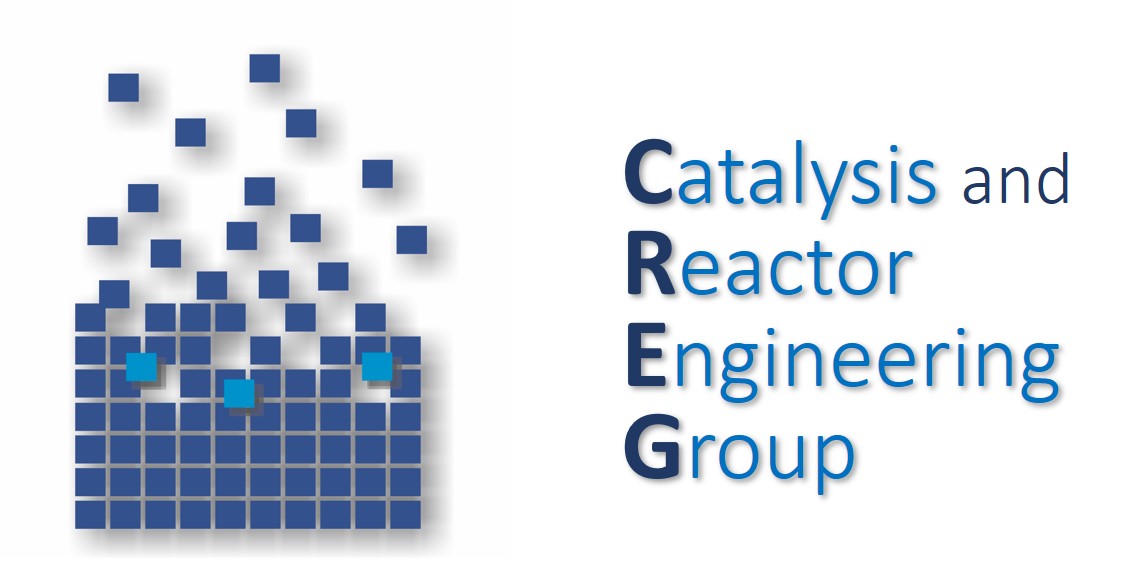
Teléfono: +34 876 555 486
Email: rgpizarro@unizar.es
Dirección: Lab 4.1.12 c/Mariano Esquillor SN Edificio I+D+i, I3A, 50018, Zaragoza (Spain)
Sideral: Ver el perfil (CV)
SOBRE MÍ
I hold a Bachelor’s degree in Chemical Engineering (2023) and a Master’s degree in Chemical Engineering (2024), both from the University of Zaragoza.
I combined my Master’s in Chemical Engineering with a position as a Junior Researcher (N4) on a research project between CREG and CEPSA Research. This project focused on the catalytic hydrogenation of CO2 for methanol production through improvements via Sorption Enhanced Reactor.
I am currently a PhD student in the field of e-fuel production from the catalytic hydrogenation of carbon dioxide enhanced by Sorption Enhanced Reactor, within the CREG (Catalysis and Reactor Engineering Group) research group at the University of Zaragoza.
PUBLICACIONES
2026
González-Pizarro, R.; Calero-Berrocal, R.; Lasobras, J.; Renda, S.; Rodríguez-Pardo, M. R.; Soler, J.; Menéndez, M.; Herguido, J.
Tuning e-fuel selectivity in sorption-enhanced CO2 hydrogenation over In2O3/ZrO2: The effect of LTA and FAU zeolites Artículo de revista
En: Fuel, vol. 406, pp. 136974, 2026, ISSN: 0016-2361.
@article{GONZALEZPIZARRO2026136974,
title = {Tuning e-fuel selectivity in sorption-enhanced CO2 hydrogenation over In2O3/ZrO2: The effect of LTA and FAU zeolites},
author = {R. González-Pizarro and R. Calero-Berrocal and J. Lasobras and S. Renda and M. R. Rodríguez-Pardo and J. Soler and M. Menéndez and J. Herguido},
url = {https://www.sciencedirect.com/science/article/pii/S0016236125026997},
doi = {https://doi.org/10.1016/j.fuel.2025.136974},
issn = {0016-2361},
year = {2026},
date = {2026-01-01},
journal = {Fuel},
volume = {406},
pages = {136974},
abstract = {The e-fuels synthesis via CO2 hydrogenation and the Sorption Enhanced Reaction technology are captivating strategies for CO2 utilization and the integration of renewable energy sources. This study focuses on enhancing the conversion of CO2 over an In2O3/ZrO2 catalyst by incorporating LTA zeolites (3A and 4A) and a FAU zeolite (13X). Key operational parameters, such as temperature (T), Gas Hour Space Velocity (GHSV), type of zeolite, and Zeolite: Catalyst mass ratio (Z/C), were systematically varied. LTA zeolites (3A and 4A) provided the highest CO2 conversions. The introduction of a water-adsorbing solid into the reactor significantly altered the products yield and selectivity. While the selectivity towards CH4, CH3OH, and C2H6O appeared to lay on the type of zeolite, the selectivity towards CO remained unaffected. Zeolite 3A demonstrated the greatest enhancement in selectivity towards CH4 and CH3OH, whereas the synthesis of C2H6O was favored by zeolites 4A and 13X. The Zeolite:Catalyst mass ratio also played a crucial role in process performance, influencing both CO2 conversion and product selectivity. Increasing this ratio improved CO2 conversion and reduced CO selectivity under all operating conditions, while CH4 selectivity increased. However, the selectivity toward CH3OH and C2H6O exhibited an anomalous and complementary behavior. While a maximum was observed for DME, a minimum was registered in methanol production, suggesting a dependency of the dehydration reaction kinetics on the amount of water produced during the reaction.},
keywords = {},
pubstate = {published},
tppubtype = {article}
}
González-Pizarro, R.; Renda, S.; Lasobras, J.; Soler, J.; Menéndez, M.; Herguido, J.
Low loading copper-based catalysts for effective CO2 hydrogenation to methanol Artículo de revista
En: Fuel, vol. 408, pp. 137642, 2026, ISSN: 0016-2361.
@article{GONZALEZPIZARRO2026137642,
title = {Low loading copper-based catalysts for effective CO2 hydrogenation to methanol},
author = {R. González-Pizarro and S. Renda and J. Lasobras and J. Soler and M. Menéndez and J. Herguido},
url = {https://www.sciencedirect.com/science/article/pii/S001623612503368X},
doi = {https://doi.org/10.1016/j.fuel.2025.137642},
issn = {0016-2361},
year = {2026},
date = {2026-01-01},
journal = {Fuel},
volume = {408},
pages = {137642},
abstract = {Methanol synthesis via CO2 hydrogenation is an emerging Power-to-Liquid (PtL) technology aimed to accelerate the energy transition and the defossilization of key sectors, particularly maritime transport. This study focuses on the study of low loading formulations, to minimize the catalyst cost. Key operational variables including temperature (T), Weight Hourly Space Velocity (WHSV), copper and zinc loadings, and aging state were systematically varied. An overall active phase loading of 10 %wt emerged as optimal. Within this total loading, a 5 %wtCu-5 %wtZn/ZrO2 catalysts delivered higher methanol productivity than 10 %wtCu/ZrO2; however, the bimetallic catalysts showed pronounced deactivation under water-rich atmospheres, establishing 10 %wtCu/ZrO2 as the most promising catalysts. Operating temperature and WHSV exerted a strong, synergistic influence on CH3OH formation; in particular, increasing WHSV shifted the reaction away from thermodynamic control and boosted methanol synthesis. Finally, the catalytic performance of these low-loading catalysts was benchmarked against high-copper-loading methanol catalysts reported in the literature by critically compare their activities as a function of the residence time (τ) calculated at reaction conditions. This assessment revealed that the proposed formulation is highly competitive when compared to most conventional formulation, with a maximum methanol space time yield (STYCH3OH) of 3.9 gCH3OH gCu-1 h-1. This comparison confirms that the catalysts proposed in this study could offer a remarkably more efficient use of the active phase than the conventional high-copper-loading catalysts.},
keywords = {},
pubstate = {published},
tppubtype = {article}
}
2025
González Pizarro, Rodrigo; Lasobras Laguna, Javier; Renda, Simona; Soler Herrero, Jaime; Menéndez, Miguel; Herguido, Javier
Intensificación del proceso para la producción de gas de síntesis via (LT-rWGS): un reactor de lecho fluidizado con alimentación continua de sorbente (CSF) Actas de congresos
vol. 13, 2025.
@proceedings{GonzálezPizarro_LasobrasLaguna_Renda_SolerHerrero_Menéndez_Herguido_2025,
title = {Intensificación del proceso para la producción de gas de síntesis via (LT-rWGS): un reactor de lecho fluidizado con alimentación continua de sorbente (CSF)},
author = {González Pizarro, Rodrigo and Lasobras Laguna, Javier and Renda, Simona and Soler Herrero, Jaime and Menéndez, Miguel and Herguido, Javier},
url = {https://papiro.unizar.es/ojs/index.php/jji3a/article/view/11917},
doi = {10.26754/jji-i3a.202511917},
year = {2025},
date = {2025-07-01},
urldate = {2025-07-01},
journal = {Jornada de Jóvenes Investigadores del I3A},
volume = {13},
keywords = {},
pubstate = {published},
tppubtype = {proceedings}
}
González-Pizarro, R.; Lasobras, J.; Soler, J.; Herguido, J.; Menéndez, M.
Proof of concept for a sorption-enhanced reactor with continuous sorbent feeding (CSF): application to green methanol production Artículo de revista
En: Chemical Engineering Journal, vol. 517, pp. 164562, 2025, ISSN: 1385-8947.
@article{GONZALEZPIZARRO2025164562,
title = {Proof of concept for a sorption-enhanced reactor with continuous sorbent feeding (CSF): application to green methanol production},
author = {R. González-Pizarro and J. Lasobras and J. Soler and J. Herguido and M. Menéndez},
url = {https://www.sciencedirect.com/science/article/pii/S1385894725053987},
doi = {https://doi.org/10.1016/j.cej.2025.164562},
issn = {1385-8947},
year = {2025},
date = {2025-01-01},
journal = {Chemical Engineering Journal},
volume = {517},
pages = {164562},
abstract = {A new reactor for process intensification using sorption enhanced reaction is described. The novelty compared with most experimental work is that a continuous sorbent feeding (CSF) provides a steady state operation. The sorbent increases the reaction rate of a reversible reaction. The reactor is based on the phenomena of segregation of solids in fluidized bed reactors by using a catalyst and a sorbent. Under certain conditions of density and particle size, the two solids segregate and the sorbent may be removed from the bed with only a small content of catalyst. The system has been experimentally tested in the hydrogenation of CO2 to methanol, using a zeolite as sorbent. A significant increase in CO2 conversion was achieved compared with the same reactor without sorbent.},
keywords = {},
pubstate = {published},
tppubtype = {article}
}
Aragüés-Aldea, P.; Pizarro, R. G.; Durán, P.; Mercader, V. D.; Francés, E.; Peña, J. A.; Herguido, J.
Catalytic CO2 methanation for biogas upgrading using a polytropic fixed bed reactor Artículo de revista
En: Catalysis Today, vol. 457, pp. 115351, 2025, ISSN: 0920-5861.
@article{ARAGUESALDEA2025115351,
title = {Catalytic CO2 methanation for biogas upgrading using a polytropic fixed bed reactor},
author = {P. Aragüés-Aldea and R. G. Pizarro and P. Durán and V. D. Mercader and E. Francés and J. A. Peña and J. Herguido},
url = {https://www.sciencedirect.com/science/article/pii/S0920586125001695},
doi = {https://doi.org/10.1016/j.cattod.2025.115351},
issn = {0920-5861},
year = {2025},
date = {2025-01-01},
journal = {Catalysis Today},
volume = {457},
pages = {115351},
abstract = {The experiments of this study aim to determine the effect of distributed feeding of reactants throughout the many inlets of a polytropic fixed bed reactor. The effect of dosing either carbon dioxide or hydrogen, was analyzed on the Sabatier reaction (i.e., carbon dioxide methanation) using a Ni-Mn catalyst to carry out the biogas upgrading process. This work analyzes the influence of three feeding configurations (a conventional fixed bed, one with side distribution of biogas, and another with side distribution of hydrogen) and temperatures (350, 375, and 400 °C) for a wide gas hourly space velocity (GHSV) range from 30 × 103 (STP) mL gcat−1 h−1 to more than 200 × 103 (STP) mL gcat−1 h−1. The molar ratios of reactants were always kept constant (H2:CH4:CO2 = 12:7:3) simulating the hydrogenation of the CO2 present in a biogas with a proportion of 70 v% of CH4 and 30 v% of CO2. The empirical results highlight that side distribution of biogas yields improved results over those obtained in a conventional fixed bed reactor, or the one with side distribution of hydrogen. At temperatures of 375 and 400 °C, this feeding configuration brings higher conversions than the other two, while consistently shows greater selectivities to methane for all the conditions tested. As such, its optimal condition to conduct the process is extended to methane space-time yields (STY), for which the highest methane productions are obtained. In addition, the influence of contact time, or GHSV, was determined to be critical both on selectivities and flowrates of methane. It is shown that for a given conversion value, keeping constant all the other parameters, a longer contact time and lower temperature result in an improvement of selectivities to methane. On the other hand, it also affects STY values, where an optimum between the employed flows of reactants and reaction performances is reached at a value of 180 × 103 (STP) mL gcat−1 h−1, independently of experimental conditions.},
keywords = {},
pubstate = {published},
tppubtype = {article}
}

